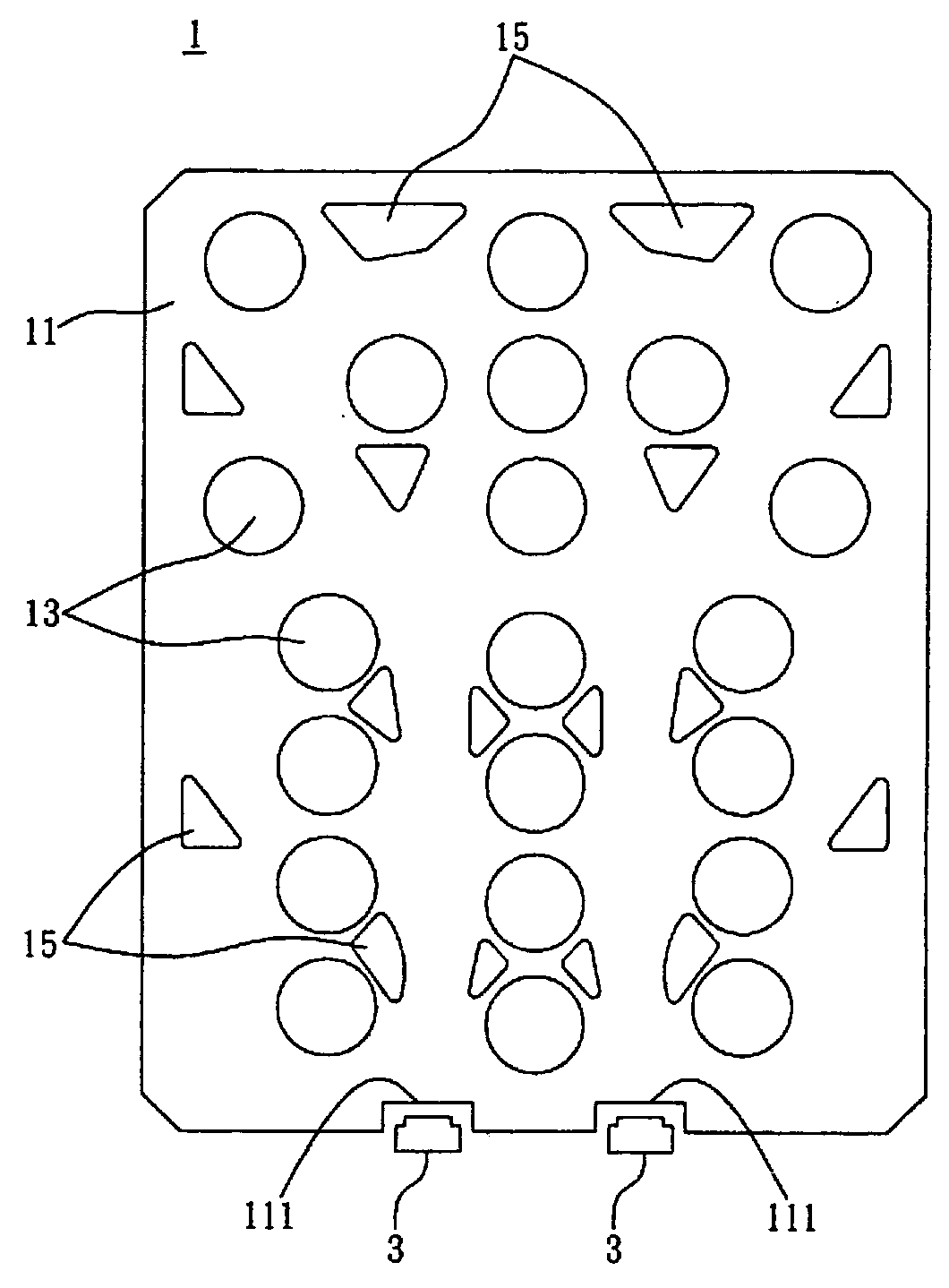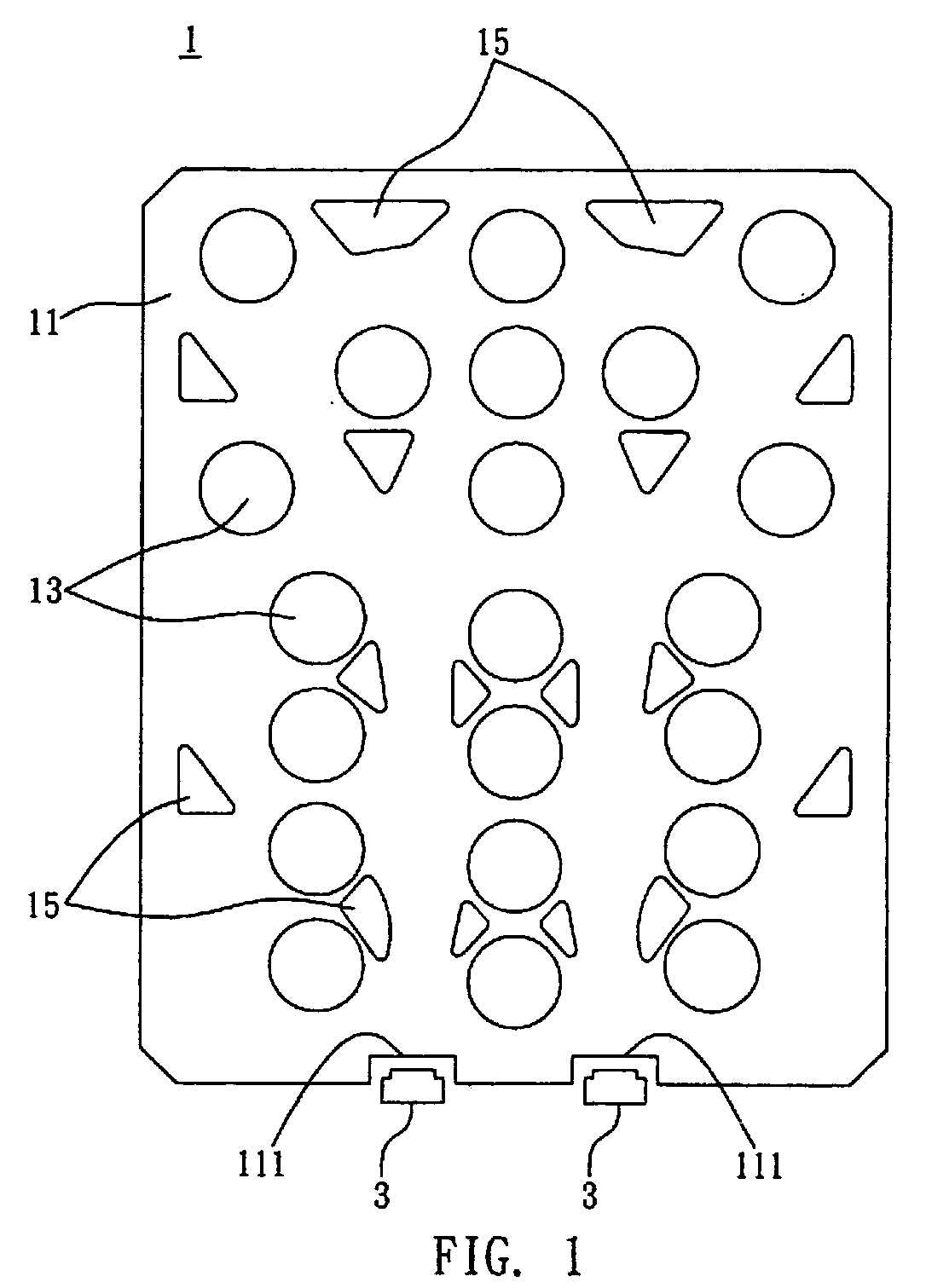Light guiding structure
a technology of light guiding and structure, applied in the direction of instrumentation, lighting and heating apparatus, planar/plate-like light guides, etc., can solve the problems of bringing the production cost higher, the cost is comparatively more expensive, and the led consumes a large amount of electricity. , to achieve the effect of improving the illumination of the keying uni
- Summary
- Abstract
- Description
- Claims
- Application Information
AI Technical Summary
Benefits of technology
Problems solved by technology
Method used
Image
Examples
first embodiment
[0032]In a first embodiment, as shown in FIG. 1, the light guiding system 1 may be installed in a portable device having a plurality of keying units (not shown) and a plurality of illuminators 3, such that incident light produced by the illuminators 3 can be transmitted and distributed to each keying unit by the use of the light guiding system 1. Further, the keying units may be exposed from a side of a casing of the portable device. In this embodiment, the light guiding system 1 comprises a light guiding structure 11; a plurality of coupling portions 13 on the light guiding structure 11 for coupling with corresponding keying units; at least an incident portion 111 for receiving incident light produced by the illuminator; and a plurality of light guiding portions 15 for guiding the incident light to each coupling portion 13.
[0033]The light guiding structure 11 of the light guiding system 1 is made of a light-transmittable material selected from the group consisting of gum, rubber, g...
second embodiment
[0041]FIG. 3 and FIGS. 4A to 4B are schematic views depicting a light guiding system 1 in accordance with a second preferred embodiment of the present invention. Most of the structure of the light guiding system 1 of the second preferred embodiment is similar to that of the first preferred embodiment, however the light guiding system 1 of the second preferred embodiment further comprises a cover member 113. In this embodiment, the cover member 113 is placed on the light guiding structure 11 at a location above a side of the incident portion 111 that is corresponding to the illuminator 3. The cover member 113 may be made of a material selected from the group comprising consisting of glass, plastic, polycarbonate (PC), polymethyl methacrylate (PMMA), polystyrene (PS), polyamide (PA), methylmethacrylate-styrene (MS), polybutylene terephthalate (PBT), polyethylene terephthalate (PET), polypropylene (PP), polyvinyl chloride (PVC), acrylonitrile-butadiene-styrene resin (ABS), polyethylene...
third embodiment
[0045]FIGS. 5A to 5E are schematic views depicting a light guiding system in accordance with a third preferred embodiment of the present invention. Most of the structure of the light guiding system 1 of the third preferred embodiment is similar to that of the first preferred embodiment, however the light guiding system 1 of the third preferred embodiment may be equipped with directed lighting (referring to the illuminator 3′ as shown in FIGS. 5A to 5D), or equipped with directed and sided lighting.
[0046]Referring to FIG. 5A, an incident portion 111′ of the light guiding system 1 is formed on the bottom surface at a location corresponding to a illuminator 3′ such as a LED. Arrangement as such may be applied to a particular area required a high intensity of illumination. Furthermore, if the light guiding system 1 is equipped with the directed lighting as well as the sided lighting (referring to the illuminator 3 as shown in FIG. 1), the directed lighting (illuminator 3′) can supplemen...
PUM
 Login to View More
Login to View More Abstract
Description
Claims
Application Information
 Login to View More
Login to View More - R&D
- Intellectual Property
- Life Sciences
- Materials
- Tech Scout
- Unparalleled Data Quality
- Higher Quality Content
- 60% Fewer Hallucinations
Browse by: Latest US Patents, China's latest patents, Technical Efficacy Thesaurus, Application Domain, Technology Topic, Popular Technical Reports.
© 2025 PatSnap. All rights reserved.Legal|Privacy policy|Modern Slavery Act Transparency Statement|Sitemap|About US| Contact US: help@patsnap.com



